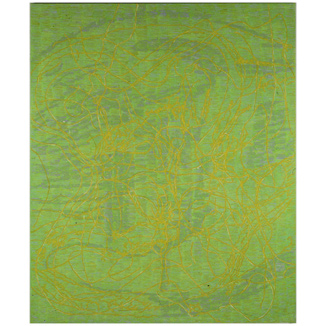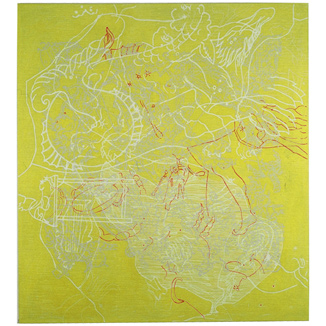Starmaps and Follies

Traces II |

Fictions |

Untitled (Star Map)Norton Rose Collection London |

Traces |

Untitled (Star Map) |

Folly |

Starmap |

Folly: Patagonian Men |

Man O'War |
Image/Contra/Image
It cannot be underestimated how important the confrontation with dominant aesthetic ideas can be for an artist during their formative years, and how these take root and inform their output long after superficial 'resemblances' have vanished. In Sharon Hall's case, as with many (one is tempted to say most) artists of her generation, it was a response to what was then called 'New Image' painting, as exemplified by European painters of then late 70's and early 80's. Unlike many of her contemporaries, she did not awake one morning to find herself transformed into a fully fledged expressionist painter of archetypal imagery. Hall's engagement with the problems raised during that period was much slower, thoughtful and intelligent. Now that we have the opportunity to see her recent paintings it is clear that many of the issues from this period still persist and have been doggedly refined into a critical consideration of how images can be used in painting, indeed, how they can be used in conjunction with their own opposition.
The imagery Hall has been concerned with over the last few years has encompassed a wide range of both chronology and subject matter (there is, however, a visual consistency which partly results from her choice of pre-photographic modes of reproduction as source material.) A mere listing might suffice here: texts and images from the letters and diaries of the '49ers', childrens primers and educational aids, 'the world turned upside down' tradition of populist prints, various early colonialist maps and engravings, as well as astronomical and navigational charts. The list might make clear her interest in the images: they are all self consciously 'historical', they create a sort of temporal distance between their original connotation and their current re-fabrication, they often reveal rhetorical purely ideological element, and, formally, their linearity enables a curious relationship to occur with the other oppositional elements in the painting, namely the seemingly autonomous systematic mark making that seems to unfold the 'time' of picture making in conjunction with the 'recitation' of the images.
David Ryan
1993
Starmaps and Follies
David Ryan
1993
Castlefield Gallery catalogue essay
...in the recent paintings it becomes obvious that Hall has shifted her method. Instead of imposing a whole outlined oneness of intention upon the canvas she builds up a further layering of possible evidence through her working method. Instead of dealing absolutely by answering a question that could never be posed through painting she approaches the country's imperial past through a fragmented accumulation of drawing. An alternately faltering and fast line hints at recognisable images. These can be attractive, decisive and unclear all at the same time. This faltering and questioning thought process has by necessity lead to the rejection of a display of false clarity of vision. In the same way that Gerhard Richter paints the blur in order to show how both the personal and photographic memory are ungraspable and unreliable, Hall dissects and crosses the surface with a build up of delicate delineation.
The relation between the process of thought and the activity of drawing is particularly naked here. By laying a trail across the canvas she describes a conceptual journey. The solid ground of so many 'clear' historical narratives has been replaced by an active involvment. The soil has been loosened and disrupted. New territories are explored.
Sacha Craddock
1993








